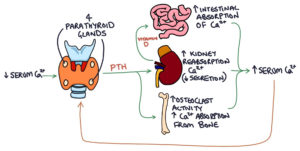Hyperparathyroidism refers to raised parathyroid hormone.
Basic Physiology
There are four parathyroid glands situated in four corners of the thyroid gland. The parathyroid glands, specifically the chief cells in the glands, produce parathyroid hormone in response to hypocalcaemia (low blood calcium).
Parathyroid hormone acts to raise the blood calcium level by:
- Increasing osteoclast activity in bones (reabsorbing calcium from bones)
- Increasing calcium reabsorption in the kidneys (less calcium is lost in urine)
- Increasing vitamin D activity, resulting in increased calcium absorption in the intestines
Vitamin D acts to increase calcium absorption from the intestines. Parathyroid hormone acts on vitamin D to convert it to it’s active forms. Therefore, vitamin D and parathyroid hormone raise blood calcium levels.

Symptoms of Hypercalcaemia
The symptoms of hypercalcaemia can be remembered with the “stones, bones, groans and moans” mnemonic:
- Kidney stones
- Painful bones
- Abdominal groans (constipation, nausea and vomiting)
- Psychiatric moans (fatigue, depression and psychosis)
Types
Primary hyperparathyroidism is caused by uncontrolled parathyroid hormone production by a tumour of the parathyroid glands. This leads to a raised blood calcium (hypercalcaemia). Treatment is to remove the tumour surgically.
Secondary hyperparathyroidism is where insufficient vitamin D or chronic kidney disease reduces calcium absorption from the intestines, kidneys and bones. This result in low blood calcium (hypocalcaemia). The parathyroid glands react to the low serum calcium by excreting more parathyroid hormone. The serum calcium level will be low or normal, but the parathyroid hormone will be high. Treatment is to correct the underlying vitamin D deficiency or chronic kidney disease (e.g., renal transplant).
Tertiary hyperparathyroidism happens when secondary hyperparathyroidism continues for an extended period, after which the underlying cause is treated. Hyperplasia (growth) of the parathyroid glands occurs as they adapt to producing a higher baseline level of parathyroid hormone. Then, when the underlying cause of the secondary hyperparathyroidism is treated, the baseline parathyroid hormone production remains inappropriately high. In the absence of the previous pathology, this high parathyroid hormone level leads to the inappropriately high absorption of calcium in the intestines, kidneys and bones, causing hypercalcaemia. Treatment is surgically removing part of the parathyroid tissue to return the parathyroid hormone to an appropriate level.
|
Hyperparathyroidism |
Cause |
PTH |
Calcium |
|
Primary |
Tumour |
High |
High |
|
Secondary |
Low vitamin D or CKD |
High |
Low / Normal |
|
Tertiary |
Hyperplasia |
High |
High |
Last updated March 2023
Now, head over to members.zerotofinals.com and test your knowledge of this content. Testing yourself helps identify what you missed and strengthens your understanding and retention.

